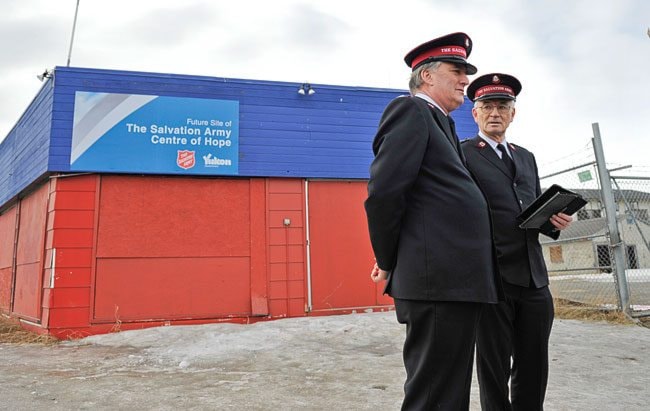The Yukon government has announced $10.2 million toward the construction of a new, larger Salvation Army shelter.
The building, to be located at the corner of Fourth Avenue and Black Street, is expected to have 25 emergency beds and 22 transitional housing beds.
The current shelter has 14 beds, and often operates at 200 per cent capacity, with additional mats placed on the floor in common areas.
Officials from the Yukon government and the Salvation Army announced the construction yesterday.
“I think of one man, Keith, who benefited from one of the Salvation Army’s transitional housing programs,” said Jim Champ with the Salvation Army.
“After 10 years on the street Keith threw away his drugs, he attended a 12-step program, and he spent 11 months at a Salvation Army transitional housing program. In a safe, clean environment he was able to focus on setting and achieving goals such as paying his rent, planning healthy meals, budgeting for and buying his groceries. “Today, Keith is a successful hairdresser and he lives in his own apartment. It’s our belief that with the building of this new Centre of Hope, that we can help even more people like Keith receive the support they need to rebuild their lives.”
The news is a long time coming. The Yukon government announced in early 2013 that it was working with the Salvation Army to build transitional housing.
That sort of service has been needed in the territory for a long time, especially for recovering addicts who are leaving treatment programs.
As it stands, people leaving the government’s month-long in-patient addictions treatment have few supports at the end of the program, and are often sent back to communities and situations that make it hard to avoid alcohol and drugs.
There are a few differences between emergency beds and transitional beds, explained Pam Goodyear, spokesperson for the Salvation Army, in an interview yesterday.
Emergency beds are intended to meet stop-gap needs of up to 30 nights, although in practice here in the Yukon that hasn’t been the case.
“For us it’s been a lot longer because there hasn’t been anywhere else for people to go, or a way to develop the skills to survive.”
Typically with emergency shelters, clients are expected to leave first thing in the morning, and take any belongings with them.
In transitional housing, a client will have their own space, where they can keep their own things.
Stays typically range from three months to a year, said Goodyear.
With transitional housing there is also an expectation that programming will be attended.
It’s about giving the necessary support so that a person can learn to live independently, she said.
“You can say, well here’s an apartment building, here’s the keys, but they don’t know how to budget, they don’t know how to pay their rent. They may not know how to go grocery shopping and get nutritional food, and how to prepare it, because they haven’t done that, especially if they’ve been living rough for a number of years.”
Programming for the Whitehorse shelter has yet to be determined, but would likely include things like addictions counselling and life skills training, said Goodyear.
While no drugs or alcohol will be permitted in the shelter, that doesn’t necessarily mean that intoxicated clients will be turned away, she said. Those decisions are typically made based on whether or not someone appears to pose a threat to staff and other clients.
The exception might be if someone is in transitional housing as part of an addictions recovery program, said Goodyear. In that case, it’s likely a zero-tolerance policy will apply.
The new facility is expected to open by the fall of 2016, at which point the existing shelter building will be sold.
Contact Jacqueline Ronson at
jronson@yukon-news.com
